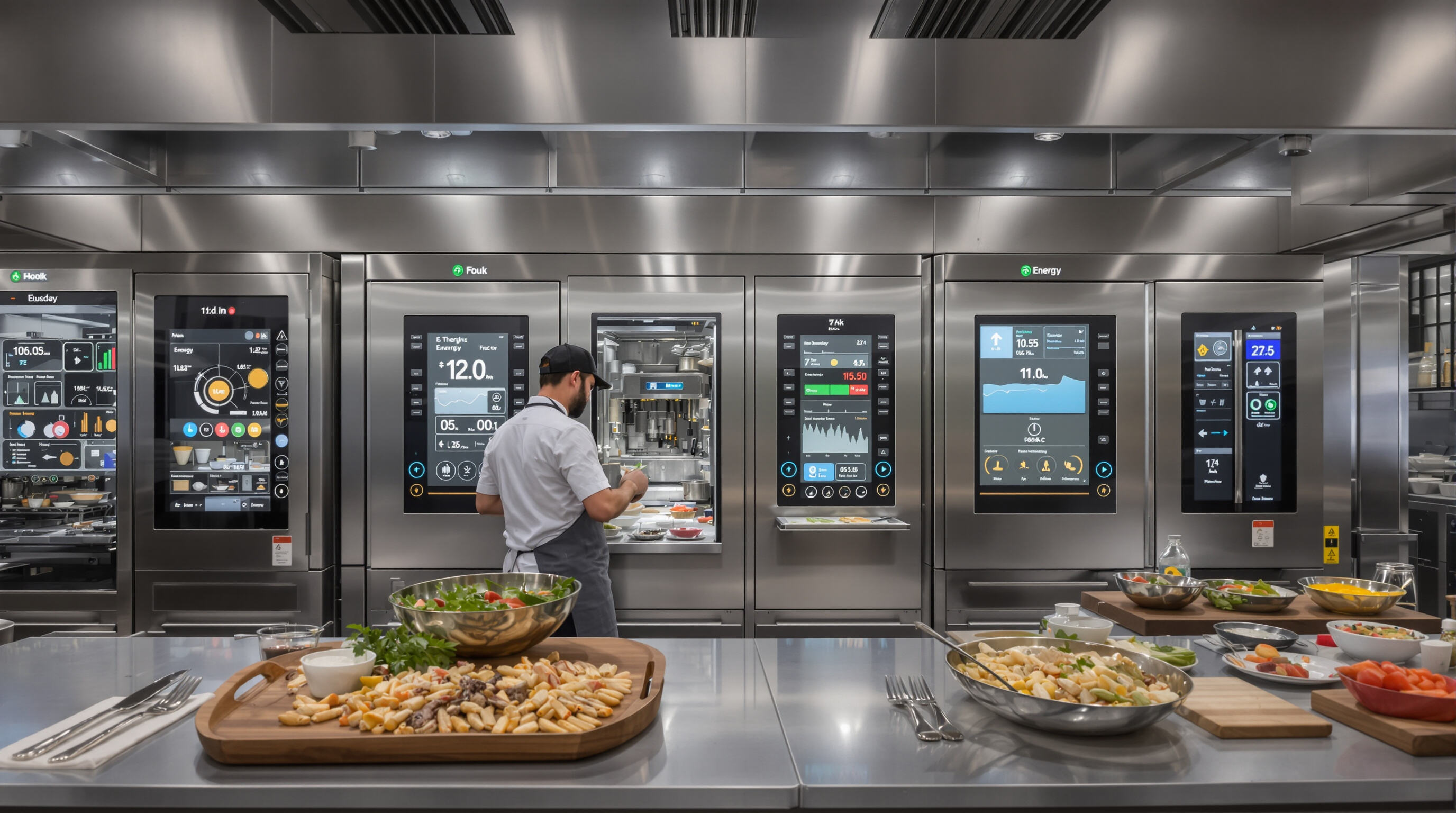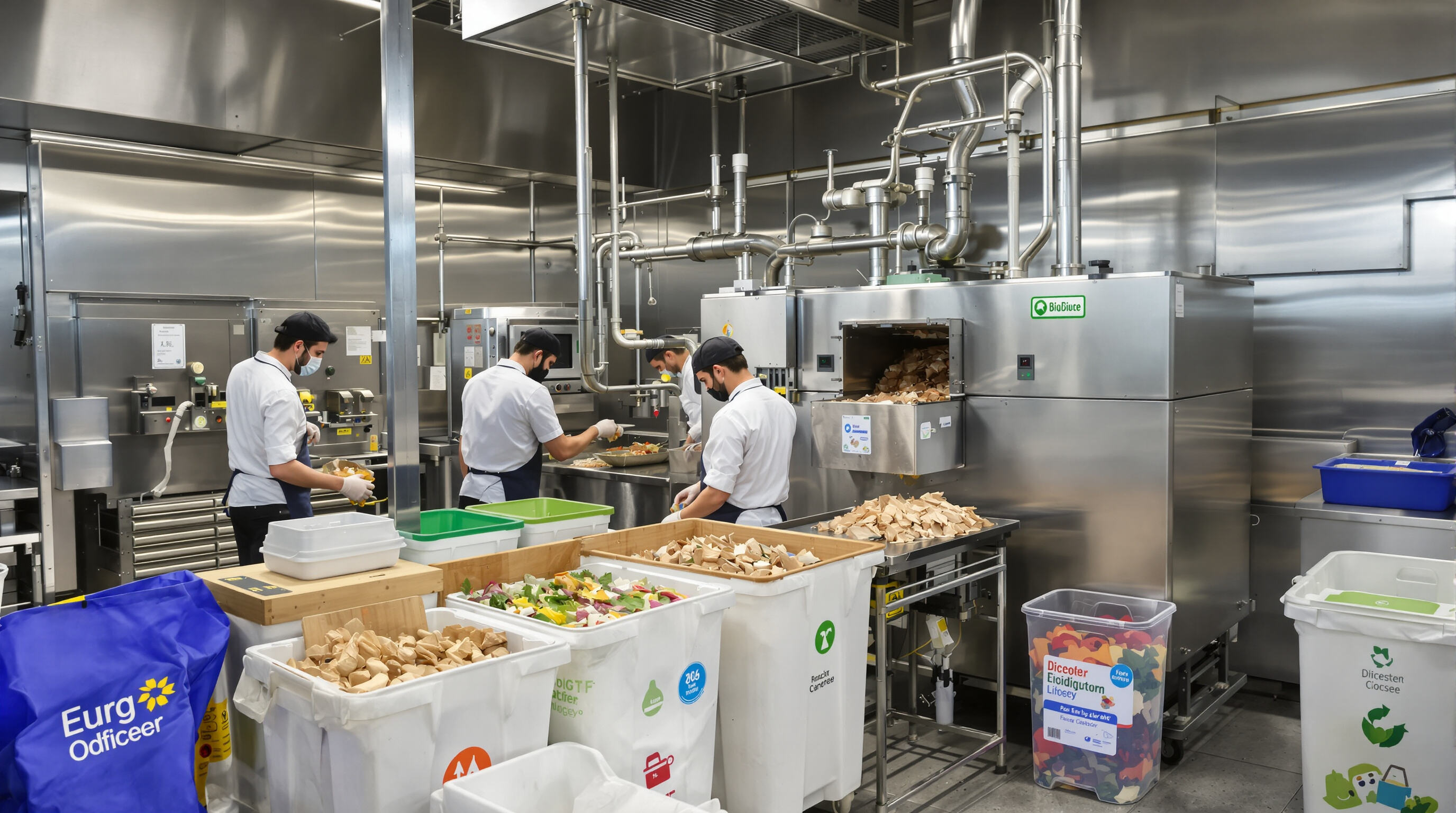Nuntii
Quomodo Coquendi Instrumenta Designatio mutatur pro Zero-Waste Coemeteriis Commercialibus
Papae Coquendi Instrumentorum in Promovendo Zero-Waste Commercial Kitchens
The Shift Versus Zero-Waste in Commercial Food Service
Plura et plura coquinae mercatales hodie in viam sine inutilibus ineunt. Ex recentibus vestigationibus mercatalibus anni 2024, fere 7 ex 10 operonibus de cibo per orbem terrarum polliciti sunt ut inutilia minuant ante annum 2030. Quae rem efficiunt? Nova machinae coquinariae quae opes servare iuvant. Instrumenta sapientia interrete coniuncta energiam consumptam et ingredientia quae per diem consumuntur observare possunt. Systemata ventilationis in coquinis novis erecta vere circa 30 percentum caloris amplius capiunt quam antiqua quae adhuc in quibusdam locis servantur. Et ne cogitare quidem oportet de inductions cocendi quae energia inutili dimidio fere minuunt comparata cum antiquis fornacibus gasi, quae propterea pro magistris cauponum parcis et rebus virescere cupientibus operationes suas sine inpendio pecuniae nimio apta sunt.
Quomodo Machinarum Cocendi Forma Inutilium Creationem Influunt
Quattuor praecipua designis elementa praecipue minuunt remissiones in coquinis mercatoriis:
- Frigibilia cum precisione regolata cum auto-filtratione vitam olei extendunt 300%
- Forni combini verticales coctionem simulatem plurium ciborum permittunt, minuendo errores coctionis nimiae
- Collectores fragmentorum integrati in stationibus praeparationis 98% praecisionum ciborum ad compostitionem capiunt
- Cupae calefactae vapore qualitatem ciborum diu duplo conservant quam in modelis conventionalibus
Haec inventa directe adiuvant metas reductionis remissionum per meliorem praecisionem, vitam productorum prolongatam, et recollectionem subproductorum simplificatam
Consonare Instrumenta cum Certificatis et Normis Sine Remissione
Ut metas sustinibilitatis assequantur, mercatores coctione armorum debent consonare tribus praecipuis normis:
- ISO 14001 pro systematibus gestionis environmentalibus
- Statio Commercialis Culinariae ENERGY STAR requirimenta, iubens reductionem 33% in usu energiae
- Societas Internationalis Nihil Residui protocolla pro fluxibus materialibus circularibus
Fabricatores respondent numeris realibus carbonii in controllis utensilium insertis, documentis examinationis facilioribus. Praeterea, unitates compatibiles catenae frigidae 18% amplius ciborum conservant quam modelli anni 2020, efficaciam inventarii augendo et nihil residui proposita adiuvando.
Incorporatio Rerum Sapiens in Ustionibus Utensilium contra Residua

Ustiones sapientes iuvant culinas commerciales pugnare contra $1.2 trillionem crisis globalis ciborum derelinquendorum (World Bank 2024). Sensibus IoT, disciplina machinalis, et rationibus praedictivis integratis, systemata haec optimizant usum ingredientium et consummationem energiae per preparationem, ustionem, et conservationem.
IoT et Monitoring Tempore Reali pro Efficientia Operationis
Sensus coniuncti praebent observationem gradus laboratorii de operatione utensilium et condicione ingredientium. A recensio 2024 de technologia culinaria IoT-instructa invenit quod monitio tempore reali errores superfluitatis minuit 38% per monitos expirationis automatos et analysim tendentiae usus, rationabilem emptionem et portionis moderationem permittens.
Fornes Potestate Artificiaria et Coctura Praedictiva ad Remissionem Overproductionis
Fornes combinatorii rete neuronicis instructi analysim venditionum historicarum et dati meteorologici praedictionem quotidiani desiderii cum 12% praecisione perficiunt. Haec facultas productionem nimiam rerum pereuntium, ut panis et proteinae—quae sunt maxima fons culinae in 2023 NRA data—praeventare adiuvat, ita ut productio cum reali desiderio congruat.
Systemata rationis et expirationis reperiendae
| Technology | Reductio Rei Ieiuniae | Impensae adimplendi |
|---|---|---|
| Tabellae RFID | 51% | $4,200/sensor array |
| Nube FEFO* | 63% | $9,800/annum |
| Praedictio desiderii AI | 44% | $15,000/SAAS |
*Primum Expiret Primum Foras algorithmi
Haec systemata augent vestigabilitatem et minuunt corruptionem, FEFO ex nube praebens summam inter technologias persequendas reductionem detriti.
De valore iudicando: Suntne lectiones sapientes necessariae aut nimis excogitatae?
Fere omnis coquendi instrumenta sapientiae sese emunt circa mensem 14 postquam installata sunt, praecipue quia minuunt iamenta ciborum, secundum recentissimam investigationem McKinsey anni 2024. Rectoribus refectoriorum oportet se conicere ad haec systemata cum iis quae iam habent pro investigatione venditionum et ratione repositi. Etiam docendi comes est, igitur tempus in disciplina idonea ponere rationem habet. Ne neglecta sit praeterea auxilium a mercatoribus qui vere suis prodigiis subsistant. Cocinis quae primum adscendebant meliora fere 22 percenta consequuntur in adimplenda iis difficultatis certaminibus zero-detritus quam loca quae adhuc utensilibus vetustis innixu sunt.
Efficientia Energetica et Complentia Environmentalis in Instrumentis Coquendi Moderne
Quomodo Regulationes Energeticae Innovationem in Instrumentis Influunt
Pressura pro efficientia energetica meliore undas movet in ratione instrumentorum culinariae commercialis hodie. Forni moderni praediti sunt moderatibus praecisis et meliore cohibitione quae remittunt energiam inutilitatem inter 15 et 25 procenta, secundum recentes indicatos a 2025. Multa systemata convectionis certificata ab ENERGY STAR sentiunt cum magis caloris opus sit vel minus, secundum quae intra se continent. Etiam ardores gasei melius facti sunt, cum ardores qui minus carburis utuntur cum cibum non coquunt. Tabernae in septendecim diversis civitatibus Americae reperiunt esse facilius ad normas strictas de emittendis gasis, tamen servitio frequenter satisfaciunt horis culminis.
Studium Casus: Ranges Basso Emissione Reducens Pedes Carbonici 30%
Unus magnus in negotio cauponarum minuit emissionem carbonis praeclarissime anno praeterito. Gessere ut eviscerarent output CO2 pro cibo circiter 32% cum istis specialibus rangebus emissionis parvis in 42 locis diversis anno 2024 ex recentissimo Rapporto Emissionum Culinariae Commercialis. Combustores emendati vere usi sunt circiter 28% minus gas metani quam antea, quod est magni momenti. Praeterea erant systemata recuperationis caloris addita quae capiebant fere duas tertias omnium energiarum thermalium despectarum et rursus in actionem revocabant pro praeincalenda aqua potius quam ut abeundum esset. Cauponae debebant fere $18k primum pro singulis locis, sed plures suos reddebant intra annum postea propter illa conservationes energiae et aliquas praestantes immunitates fiscales pro operibus viridibus.
Materiae Sustentabiles et Consilia de Tendis Consapegnis Climatis
Multi fabricatores iam coepisse sunt uti ferro inox aut circa 85 percentum recens cum ceramicis compositis induratis cum suis instrumentis condendis. Nuper nomen magnum in arte edidit quoddam isolamentum biodegradabile ex reliquiis agrorum factum, quod minuit emissionem carbonis tempore quasi 20 percentum respectu optionum traditionalium ex vitro. Fabricatores instrumentorum etiam sapientiores fiunt de designo nuper. Eorum ratio modularis significat partes omnes facile dissolvi posse ad emendationem vel reponendas in systemate ad rursus utendum. Huiusmodi ratio certo convenit cum eo quod EPA proposuit per suum 2030 Planum de Gestione Materialium Sustentabilis, sed videtur consilia magis alicuius motivi quam tantum regulas sequendi.
De Iniuria ad Lucrum: Biodigestoria et Compositio in Processibus Culinariis

Biodigestoria ut Instrumentum Principale ad Remotam Obstitis Organici Gestiones
Coquinae mercatales incipiunt nunc magnopere in biodigestoribus inniti. Hae machinae possunt convertere circiter 80 usque ad fortasse 95 procenta totius ruti ex coquina in aliquid satis tutum ut aqua caesia vocetur, quod significat minus refectum in compitulis publicis deficiens. Ars mirabilis per digestionem anaerobicam fit, methodum quam ratio demonstrat bene operari cum in ambitu urbico amplificatur. Fragmenta cibi digeruntur sine generatione eorum noxiorum gazorum methane quae e compitibus vulgaribus exeunt. Antiquae methodi proiciendi ruti plerumque requirunt multas saccos plasticos et vehicula ruti extrinsecus transportanda, sed biodigestores non ita sunt. Capito unam catenam medii hotelis quae hunc systema implementavit. Illi potuerunt retinere circiter duodecim tonnas ruti coquinarii e compitibus singulis annis. Id fere aequatur ei quam 18 tonnas metricas carbonis dioxidis a nostro atmosphaera prohibere, secundum eorum calculos.
Systemata Compostandi cum Operibus Coquinariae Integrandum
Cum abiciamus fragmenta cibaria et sediments ex caffe, potius quam eos componere, quasi abicimus fimum gratuitum pro hortis nostris. Loca parva in culina valde proficiunt ex siccatoribus qui minuunt volumen composti circiter tres quartas partes antequam dies colligendi adveniat. Et illi parvi clausori organici? Vitam seruant pro servando omni illo sordido organico sine spatio nimio occupando. Studia demonstrant quod compositio recta prohibet circiter 40 percentus nitrogenii noxii ne in tenebris acervis fiant, quod quidem pulchrum est cum de eo cogitaveris. Praeterea, nunc multi agricolae urbani societatem faciunt cum tabernis ut sordes in aliquid utile vertantur ad producenda nova genera ciborum. Qui prudentes sunt disponunt opus cibarii ita ut solum generate sordes satis ad tractandas intra unum aut alterum diem, olores removendos et omnia pura et tractabilia in area culinae servanda.
Synergia principalis : Iunctura digestorum cum putrefactione creat systema circuitu clauso ubi plus 90% materiae sordidae iterum uti potest, et ita quotannis $2,100—$4,800 salva sunt in expensis tollendis (certamina 2024 de sordidarum rectione).
Effectus in Re: Exempla in Metamorphosi Cucinae Sine Sordibus
Cucinae praecipuae monstrant operationes sine sordibus non solum posse sed etiam lucrum afferre per rationem instrumentorum mutandorum et technologiae coniunctionem.
Recondita Instrumenta Coquendi Pro Zero-Sordibus in QSR Catena Nationali
Unum magnum tabernaculum cibariae celeris dimidiam fere sordium quantitatem minuit cum vetera instrumenta novis substituit. Novi coquorum exacti numeri prohibuerunt ministerium ut nimis cibi pararent simul, quod antea problema magnum erat. Eorum refrigeration structura etiam est emendata cum his pulchris unitatibus modularibus quae vere habent canales compostandi in se insertos. Haec sola mutatio censum vertit ut mensis singulis circiter 28 tona fragmentorum cibarii ex tenebris effugent. Neque obruuntur furni combinatorii illi elegantes qui et coquere et vapore coquere possunt. Hi furni singulis annis circiter 15 milia galonarum aquae in singulis locis mercati salvant. Coquinae incipiunt sentire quod instrumenta culinaria sapientiora non solum de pecunia parienda in expensas, sed etiam de meliore custodia rerum naturalium diuturna ratione versantur.
Successus Coquinae Hotel: Minuendo Res Cibariae cum Systematibus Sapiens Integris
Hospitia nobilia eo usque pervenerunt ut refectum cibum minuerint circiter quadraginta percento, gratias agentes nescio quae machinae culinariae arte magica instructae. Nunc ingredientium rationem gerunt in tempore reali, cum clavis furnis quae spectant in tabulas reservationum et determinandae sunt quantitates coquendi, et id ipsum centies millies bis terque atque nonagies septies fere bene evenit. Cum ministeria culinaria animadvertunt reliquiis ciborum nimis collatis, monitus accipiunt, ut ex iis rebus ad usum revocatis potius quam in sterquilinio projiciendis. Idem technologia monetam etiam conservat, eo quod aedificia refectoria minus impendunt in mercationibus circiter duobus et viginti percentis. Quomodo? Algorithmo callido comparantur res quae ordinantur cum necessitatibus clientium, ut minus cibo intercidat et putrescat priusquam quis eum gustaverit.
FAQ
Quid est zero-refectum in culinis mercativis?
Zero-waste in culinis commercialibus adhibetur ad praxim qua generationem sordiditiae minuitur, technologiis et methodis utentes ut res uti, recyclare et optimizare usum rerum, denique sordes mittendas ad sordidularia minuendo.
Quomodo apparatus coquendi intelligentes adiuvant ad finis zero-sordiditiae?
Apparatus coquendi intelligentes minuunt sordes cibarias et energeticas AI, sensoribus IoT et rationibus praedictivis utentes ad optimandum usum ingredientium, adiumento efficacitatis energeticae, custodientes tempus expirationis et congruendo productionem cum vera indigentia.
Num ineptum est omnibus culinis commercialibus in technologiam intelligentem investire?
Quanquam saepe technologia intelligens sese redimat minuendo sordes cibarias et meliorando efficacitatem operationum, pretium eius pendet a necessitatibus singulis culinis, pecuniae dispositione, structura iam existente et studio reductionis sordiditiae.
Quid sunt biogeneratoria et quomodo operantur?
Biodigestoria sunt machinae quae sordes organicas in aqam turbidam vertunt per digestionem anaerobicam, sordes in locis sordiditatis minuentes dum emissio methane impeditur. Praeterea, necessitatem methodorum traditorum ad tollendum sordes, ut saccis plasticis, minuunt.
Quomodo systemata conpositionis culinas mercatorias iuvant?
Systemata conpositionis fragmenta ciborum in solum fertilissimum convertunt, sordes in locis sordiditatis et emissionem nitrogenii noxii valde minuentes, dum ad prataculturam sustinendam conferunt saepe cum agris urbanis coniunctis.
 Post-Sales:
Post-Sales:
 EN
EN
 AR
AR
 HR
HR
 NL
NL
 FI
FI
 FR
FR
 DE
DE
 EL
EL
 HI
HI
 IT
IT
 PT
PT
 RO
RO
 RU
RU
 ES
ES
 TL
TL
 ID
ID
 SL
SL
 VI
VI
 ET
ET
 MT
MT
 TH
TH
 FA
FA
 AF
AF
 MS
MS
 IS
IS
 MK
MK
 HY
HY
 AZ
AZ
 KA
KA
 UR
UR
 BN
BN
 BS
BS
 KM
KM
 LO
LO
 LA
LA
 MN
MN
 NE
NE
 MY
MY
 UZ
UZ
 KU
KU









